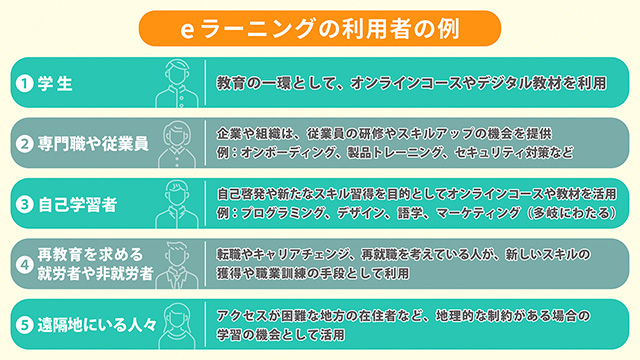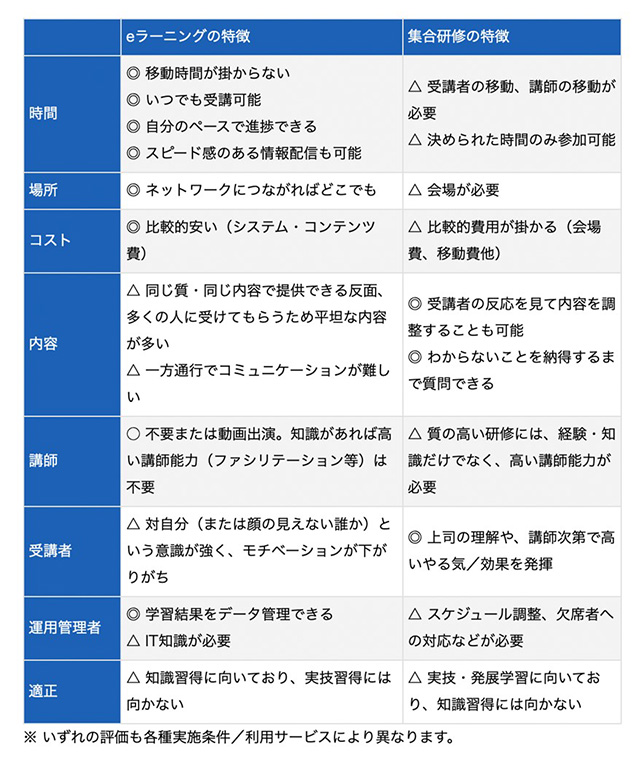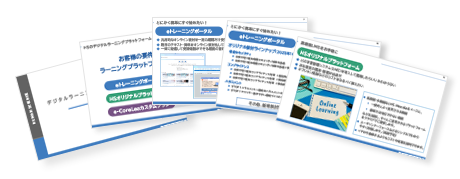2023.06.15
What is e-learning? Explanation of system overview and benefits
With the advent of the internet, e-learning has brought about a new form of learning, where educational content and learning platforms are easily accessible. It has become a highly efficient learning method for those who want to learn at their own pace, without being tied down to a specific location. In this article, we will introduce the basic knowledge, benefits, and specific usage methods of e-learning in detail.
1. What is e-learning?

e-learning is a learning style that uses electronic devices such as computers, smartphones, and tablets to acquire knowledge through the internet. The "e" stands for electric and "learning" refers to the act of learning.
e-learning is a common practice for accessing online courses and training programs. Learners can access content and learn at their own pace, at a convenient time and place. Unlike one-time workshops, e-learning allows for repeated learning. Additionally, e-learning can incorporate interactive elements, which can improve learning effectiveness, participation rates, and completion rates.
Currently, it is being utilized in various fields such as school education and corporate training. Examples include online universities, vocational schools, and internal training programs for companies. In addition, in recent years, the demand for e-learning, which allows learning from home, has increased rapidly due to the spread of the new coronavirus.
<Learning Designer's Example>

(1) Students
As part of school and university education, online courses and digital materials may be used.
(2) Professionals and Employees
Companies and organizations are introducing e-learning and providing opportunities for employee training and skill improvement. Examples of educational programs include onboarding, product training, and security measures.
(3) Self-Learner
Individuals may also use online courses and materials for self-improvement and acquiring new skills. Learning fields include programming, design, language, marketing, and more.
(4) Workers and non-workers seeking re-education
For those aiming to change jobs or careers, or considering re-employment, e-learning can be a means of acquiring new skills and vocational training.
(5) People in remote areas
e-learning provides learning opportunities even for people who live in areas with difficult access, such as residents in remote regions.
As such, e-learning can provide a flexible learning environment for many people regardless of age or background.
2. Latest Information on e-Learning

Today, e-learning is widely used, but it is said that e-learning became popular in Japan around 2000. At that time, the spread and acceleration of the internet led to a rapid development of online learning. In addition, in the mid-2000s, "Web 2.0" emerged, making interactive learning experiences possible. Since then, mobile devices such as smartphones and tablets have continued to appear, and e-learning has become even more widespread.
In addition, with the advancement of technology such as the high-speed internet and evolution of devices, e-learning itself has changed from just a tool for "transferring knowledge" to a more effective tool for providing "experiential learning" for better retention of knowledge.
So, what kind of learning experience can we have with current e-learning? We will provide you with the latest information on the changing e-learning.
(1) Microlearning
A learning style where learners can efficiently learn small topics at their own pace in a short period of 1 to 5 minutes. It has the benefits of utilizing free time effectively and being able to maintain concentration.
(2) Utilizing AI (Artificial Intelligence)
By utilizing AI, we can provide a customized and optimal learning plan based on the learner's progress, requests, and performance. Additionally, we can analyze learning outcomes and use that information to improve the learning process.
(3) Collaboration with Education Big Data
Education Big Data refers to the collection and analysis of various educational information such as learners' progress, behavior, and evaluation data on a large scale. By utilizing this data, we can provide precise and accurate evaluations, support, and education improvement plans like never before.
(4) Active Learning
Active learning, where learners actively engage in learning, is different from traditional passive learning (learning with one-sidedly given content) and is ideal for acquiring human skills such as "dialogue skills" and "negotiation skills". There are a variety of content such as online discussions and group work.
(5) VR (Virtual Reality) and AR (Augmented Reality)
Virtual reality (VR) and augmented reality (AR) are also gaining attention as learning methods. By utilizing these technologies, it is possible to simulate difficult scenes such as disasters and medical settings in a realistic way, allowing for a more practical learning experience.
(6) Collaboration with Social Learning
Collaboration between learners and social learning is also effective for solidifying knowledge. Through online communities, discussion forums, and collaborative tools, learners can exchange information and opinions, and learn together while cooperating.
By combining various learning methods like this, we can provide the most suitable e-learning for each individual learner's needs, leading to the realization of the "best learning experience".
3. Benefits and Drawbacks of e-Learning

So far, we have explained what e-learning is, but what are the actual advantages and disadvantages? In this chapter, we will discuss the advantages and disadvantages of e-learning compared to face-to-face group training, from both the learner's and administrator's perspectives.
◎ Benefits for Learners
(1) Learning results are recorded
Delivery and attendance of e-learning is generally managed by an LMS (Learning Management System), so individual learning history and grades are recorded on a server or other system. The recorded data can be accessed by administrators at any time. Therefore, learners can receive objective evaluations.
(2) You can learn at your own pace anytime, anywhere
Unlike group training with set dates and locations, e-learning can be done anytime, anywhere as long as you have a mobile device and internet connection. The freedom to learn at your own pace without any restrictions is a major advantage. This also leads to the habit of learning, as it can be done easily and casually.
(3) Can be reviewed as many times as needed
Group training ends on the day of the session. Even if you have the text material, the opportunity to be taught is only once. On the other hand, e-learning allows for repeated learning, so you can thoroughly review and repeat until you understand.
● Disadvantages for Learners
(1) Difficulty maintaining motivation
Depending on the individual's personality, there are many who say they enjoy the "lively atmosphere of group training". On that day, they leave their work behind and learn together with everyone. For those who use this contrast as motivation for training, it is expected that they will not be satisfied with e-learning and will not feel motivated to do it.
Unlike group training where you can participate with just yourself, e-learning requires an internet environment and device. However, it is now common for companies to provide personal computers and many companies also allow the use of personal devices for e-learning with certain conditions.
◎ Benefits for the Administration Department
(1) Can provide homogeneous education to a large number of learners
In group training, the number of participants per session is limited. Also, even with the same text, there may be variations in the "quality of education" depending on the instructor. With e-learning, the same educational content can be delivered regardless of the number of participants.
(2) Lower Cost Compared to Group Training
When AUTOBACS SEVEN CO., LTD., a pioneer in introducing e-learning, conducted a cost calculation, it was found that using e-learning for their educational initiatives was approximately four times more expensive than conducting group training.
(3) Diverse Methods for Acquiring Learning Materials
There are various methods for acquiring learning materials for e-learning, such as purchasing ready-made products, ordering custom-made products, customizing ready-made products, and producing them in-house (often referred to as in-house production). By combining these methods, it is possible to create originality and pursue the ideal educational strategy.
● Disadvantages for the Administration Department
(1) IT Literacy is Required
e-Learning requires a certain level of IT literacy from both administrators and learners, as digital devices such as computers and smartphones are used. In addition, since personal information of learners may be required, knowledge of privacy and personal information protection, as well as the establishment of security measures, are necessary.

4. How to Use e-Learning Specifically
Here, we will introduce what can be done specifically in e-learning for learners and administrators.
■ What learners can do with e-learning
e-learning offers various learning environments and content tailored to individual learning styles. Using the open-source LMS (Learning Management System) Moodle as an example, there are often opportunities for interaction with administrators and instructors, such as submitting reports and assignments, answering surveys, and asking questions. Additionally, some systems are equipped with features to facilitate communication between learners. Through this interactive learning, learners can become more motivated and expect to see improvements in their learning outcomes.
For more information on Moodle, please visit this page.
〈Specific Functions〉
・Viewing training/class materials
・Downloading training/class materials
・Attendance for training/classes
・Workshops
・Interactions in group/individual forums
・Questions
・Surveys
・Today's To-Do List
・Submitting reports/assignments
・Tests ・Private files...and more
■ What administrators can do with e-learning
For the already existing "Moodle", administrators can easily manage the progress of each learner by utilizing its functions such as attendance and grade management. Furthermore, by analyzing the progress data and generating reports, it can also be useful for learning plans, instruction, and course improvements. In addition, with the registration of teaching materials, it is also possible to easily conduct tests, surveys, and report submissions.
〈Specific Functions〉
・Attendance Management
・Online Training/Courses
・Upload of Training/Course Materials
・Grade Management
・Report/Assignment Management
・Report/Assignment Grading and Evaluation
・Test Implementation
・Test Quality Analysis
・Progress Management Report
・Completion Certificate
・Open Badges
・GDPR (General Data Protection Regulation)
・SSO (Single Sign-On: Seamless System Access through Authentication Integration)
・MFA (Multi-Factor Authentication)
・Advice in Group/Individual Forums
・Feedback
In addition, if the LMS is an open source such as Moodle, it is also possible to add necessary functions through plugin development. By customizing the functions freely, it is possible to create a more user-friendly and effective e-learning environment.
5. Three Things Needed for Introducing e-Learning
By utilizing feature-rich e-learning, it has been found that high-quality learning experiences can be easily and efficiently provided. In order to introduce such e-learning, it is necessary to have ① e-learning system (LMS), ② teaching materials, and ③ support system for learners.
Let's take a closer look at these three elements.
① e-learning system (LMS)
When introducing e-learning, the base is "LMS". This is an abbreviation for "Learning Management System" and is also called a learning management system. Many LMSs have the functions introduced in the previous chapter, and can manage learner registration, progress, and learning content upload and settings.
One of the representative LMS is "Moodle". Moodle is an open-source all-in-one learning platform and is widely used as a world standard LMS.
*For more information about Moodle, please see this page.
>Introduction and Support for LMS by Human Science Co., Ltd.
② Teaching Materials
After building the operational environment for e-learning using an LMS, the next step is to focus on the "content" of the learning. In other words, the materials. There are mainly three methods for preparing materials.
〈How to Prepare Learning Materials〉
・Use materials provided by e-learning providers
・Request production from e-learning providers and create original materials
・Produce in-house (with support from e-learning providers for internalization)
Generally, LMS conforms to SCORM (Sharable Content Object Reference Model: a standard for standardizing e-learning). Therefore, the material itself needs to conform to SCORM in order to function correctly on the LMS. By using SCORM-compliant materials, there are benefits such as being able to use the same materials in different LMSs.
*For more information on SCORM, please see this page.
To create materials compliant with SCORM, it is recommended to use e-learning content creation tools such as "iSpring Suite" or "Storyline". In particular, "iSpring Suite" can easily create learning content as a PowerPoint plugin software.
However, since a certain level of knowledge is required for creating materials, it is common to ask a technical specialist with expertise. If you want to prepare materials, it is recommended to consult with an e-learning provider.
>Human Science's e-Learning Material Production Service
Support System for Learners
When operating e-learning smoothly, one cannot ignore the support system for learners. This includes technical problem solving, smooth management of learning progress, and also taking care of learners. E-learning is primarily done individually, so there is a possibility of learners feeling isolated or losing motivation.
In addition, if there are support staff such as learning advisors (those who provide total care for learning) and tutors (those who answer questions about learning materials), they can help resolve learners' concerns and lead to increased motivation and improved results.

6. Take the first step together to start e-learning
e-learning is an innovative learning method that has emerged from the fusion of digital technology and the field of education. In the 2000s, the use of LMS expanded even further and it is now utilized in various educational settings.
At the same time, Human Science has been involved in creating e-learning materials since the early days of e-learning in Japan, and has built a track record of over 20 years. We hope that you can make use of our rich experience and expertise to benefit your business.
If you are interested in e-learning and want to try it out, or if you are facing challenges or concerns such as "employees' motivation is not increasing" or "the effectiveness of education is not visible", please consult us. We will propose the most suitable plan for employee education, with both efficiency and effectiveness.
>Human Science's e-learning service

Latest Blog
- 04/02/2024
- English Learning Using Moodle and ChatGPT












